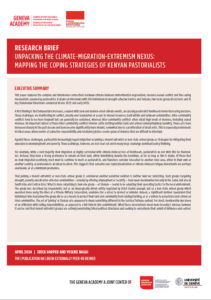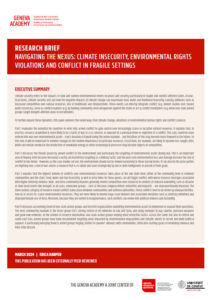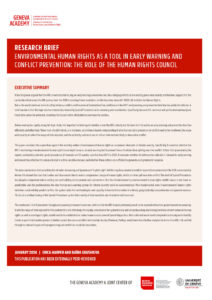This project explored how environmental degradation, resource insecurity and conflict dynamics intersected with the protection of the human right to a clean, healthy and sustainable environment. It investigated how environmental rights violations, climate-related risks and governance failures contributed to insecurity, conflict escalation and human rights harm, and how international law, institutions and policy frameworks could respond more effectively.
Conducted between May 2023 and late 2024, the project focused on six country “hotspots” where environmental conflict spill-overs were most acute. It aimed to develop guidance for security, environmental and human rights actors and to identify entry points for action within United Nations Human Rights Council (HRC) and United Nations Security Council (UNSC) settings. The research contributed to ongoing discussions about prevention, resilience and early warning by advancing the integration of environmental rights into the human rights/conflict/security nexus.
The project pursued three core objectives, each addressing a distinct dimension of the intersection between conflict/security and the right to a clean, healthy and sustainable environment.
Environmental Rights and Conflict Risk
This strand analysed how violations of the human right to a clean, healthy and sustainable environment—such as environmental degradation, resource depletion and ecosystem disruption—acted as drivers or accelerators of conflict, insecurity and human rights harm. It examined how environmental rights abrogation interacted with human vulnerability, displacement and governance failure.
Early Warning, Resilience and Environmental Governance
This component assessed how environmental rights frameworks, governance mechanisms and early warning systems could contribute to conflict prevention, resilience-building and the protection of vulnerable populations. It explored how monitoring environmental and human rights indicators could strengthen early warning and inform policy interventions in fragile and conflict-affected settings.
Legal Frameworks, Institutional Response and International Law
This strand evaluated how international human rights law, IHL and international environmental law could be better integrated to address the human and environmental consequences of warfare. It analysed how responsibilities of States (and non-State actors) to protect the environment, remediate harm and safeguard human rights could be operationalised in conflict and post-conflict contexts, and how institutional entry-points (HRC, UNSC, treaty bodies) could be leveraged.
Cross-cutting Questions
What legal and institutional reforms were needed to close gaps between environmental harm, human rights protection and accountability in armed conflict settings.
Across these strands, the project addressed:
Which environmental rights violations most reliably signalled heightened conflict risk or insecurity?
How environmental governance failures and resource depletion contributed to human rights harm in conflict settings.
How monitoring environmental rights could function as an early warning tool.
The project produced a series of research papers and policy analyses that examined the environment–conflict–rights nexus and offered guidance for practitioners and policymakers.
Research Briefs and Papers

Unpacking the Climate Migration Extremism Nexus Mapping the Coping Strategies of Kenyan Pastorialists
Geneva Academy of International Humanitarian Law and Human Rights
Erica Harper, Yosuke Nagai

Unpacking the Burgeoning Challenge of Environmental Protection and the Right to Food in the Context of Armed Conflict
Geneva Academy of International Humanitarian Law and Human Rights
Erica Harper, Junli Lim

Navigating the Nexus: Climate Insecurity, Environmental Rights Violations and Conflict in Fragile Settings
Geneva Academy of International Humanitarian Law and Human Rights
Erica Harper

The Human Right to a Clean, Healthy and Sustainable Environment: Understanding its Scope, States Obligations and Links with Other Human Rights
Geneva Academy of International Humanitarian Law and Human Rights
Christophe Golay, Baïna Ubushieva

Environmental Human Rights as a Tool in Early Warning and Conflict Prevention The Role of the Human Rights Council
Geneva Academy of International Humanitarian Law and Human Rights
Erica Harper, Baïna Ubushieva

Climate Change in the Security Council: Obstacles, Opportunities, and Options
The Geneva Academy of International Humanitarian Law and Human Rights and the United Nations University
Erica Harper, Adam Day
Policy Guidance and Engagement Tools
The project developed guidance notes and policy documents for human rights, security and environmental actors. It identified institutional entry-points for analysis and action at the HRC and UNSC, and provided frameworks for leveraging environmental rights in prevention strategies.
Contribution to Ongoing Debates
Findings from the project continued to inform training, practitioner dialogues and policy engagement at the Geneva Academy beyond the project’s conclusion.
The project convened several workshops, roundtables and policy dialogues that examined the intersection of environmental rights, conflict risk and human security.
Country-Focused Workshops
Workshops held in six country hotspots examined how environmental degradation, conflict spill-over and governance failures shaped human rights risks and informed early warning approaches.
Expert Roundtables
Expert discussions gathered states, UN actors (HRC, UNSC) and civil society specialists to reflect on the role of environmental rights in conflict prevention and to discuss how the human rights system could respond more effectively.
Policy Briefing Sessions
Targeted briefings with decision-makers in Geneva and New York presented interim findings and explored institutional and legal entry-points for prevention, resilience-building and environmental rights monitoring.
The project was carried out by researchers at the Geneva Academy with expertise in human rights law, environmental law, conflict analysis and early warning.
Erica Harper, Head of Research and Policy Studies at the Geneva Academy, led the analytical framework and contributed to the project’s research outputs.
The project was conducted in collaboration with environmental rights organisations, civil society partners, and UN actors.
The project was supported through the Geneva Academy’s research funds and external partnerships, enabling the development of analytical work on environmental rights, conflict and human security, and the organisation of expert dialogues and country-level workshops.

